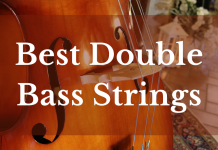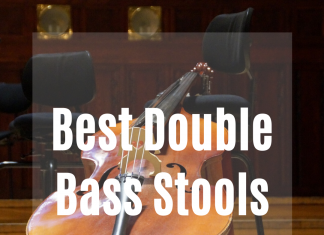You’re not alone if you aren’t quite sure what this instrument is. For those who are not musicians, and who only vaguely remember high school music class, the double bass might just register as an obscure string instrument, but it’s so much more than that.
What Is a Double Bass?
Otherwise known as the bass, the double bass is the largest and lowest-pitched bowed string instrument in a modern symphony orchestra. Musicians who play the double bass are referred to as bassists. The bass is played with a long bow called an arco, or by plucking the strings.
There are other extended techniques to playing the bass, depending on the genre of music. For instance, ‘silent’ fingering refers to fingering pitches with the left hand, minus the bow or the plucking of strings. This is one of the more common techniques, particularly in Jazz.
How Large Is a Double Bass?
The double bass stands around 180 cm long, or 6 feet. Other sizes are also available, such as 1/2 or 3/4 of the regular size. These other size options accommodate a player’s height and hand size. If you’re a relatively short person, there is no need to fear whether you will be able to handle the bass! It may be a bit of an encumbrance to carry around, but that is expected for an instrument of this size.
Appearance and Types
This instrument is made primarily of wood, with specific parts of the instrument constructed from different types. Double bass’ of orchestral quality are made of maple (back, neck, and ribs); spruce (top); and ebony (fingerboard, tailpiece). Types differ depending on the genre of music most suitable: Dance, Jazz, Orchestral, and Solo.
Sounds of the Double Bass
The sound of the double bass begins with its vibrating strings. Its sounds are determined by the placement of the bow or where it is plucked or struck. Pitch is modified by the thickness, tension, and length of the string, similar to all instruments in the strings category.
Due to its large, hollow body, the bass emits low muted tones, at times rhythmic, and at others long. The double bass issues an incredibly powerful sound and often forms the foundations underlying the more prominent sounds in the orchestra.
Playing the Double Bass
The bass is an upright instrument, placed vertical with its end rested firmly on the ground. Unfortunately, the double bass is not easy to play compared to other instruments. You’re better off starting with a less complex string instrument like the guitar, as you learn music theory and can work up to playing the bass.
How Much Does a Double Cost?
Reasonable pricing for a beginner’s double bass is around $1500 USD. Most people new to the instrument start with a rental. Rental costs are difficult to predict, as many music stores offer discounts to music students. A reasonable estimate would be $22 USD/month for a small version to $74 for the largest model, with costs varying across sizes. These prices were generated for basic double bass models. Buying and rental costs can be much higher for top quality instruments.
Famous Players of the Double Bass
- James Jamerson: He wrote the bible on bass line development and construction, feel, syncopation, tone, touch, and phrasing. Jamerson was Funk Brother #1 in Motown’s “Snake Pit,” and he played with the likes of Stevie Wonder, Marvin Gaye, Diana Ross, and the Supremes. Jamerson was active as a bass player from 1956 to 1983.
- Jaco Pastorius: Between 1975 and 1982, he made important contributions to music by Pat Metheny, Joni Mitchell, and Weather Report. As +an exceptional electric bass player, his untimely death shocked the musical community in 1987.
- Paul McCartney: Paul McCartney played electric bass front-and-center as a member of iconic music group, The Beatles. The most notable piece featuring McCartney’s double bass is the 1967 studio album, Sgt. Pepper’s Lonely Hearts Club Band.
- Larry Graham: Legend says that Graham played organ pedals and guitar as a teenager, then switched to the bass when his organ broke. He is known for his “thumping thumb” Jazz beats with Sly & the Family Stone. Graham is a long-standing bassist, having begun to play in 1961 and continues to perform today.
- Stanley Clarke: Clarke is considered the first superstar bassist in music history, and has continued to play since 1996. His bass playing is largely inspired by Coltrane, and he took the acoustic bass to never-before-seen technical and musical heights with the SMV band.
You can find other famous double bass and bass guitar players here.
The Origins of the Double Bass
Most stringed instruments in the viol family originated in Italy at the end of 15th century – some historians argue it was actually the beginning of 16th. Either way, it’s safe to say that by the middle of the 16th century, the double bass was sharing the stage with other members of the viol family.
Like most of these instruments, the Double Bass descended from other stringed instruments, in this case, the viola da gamba. In fact, even today, the bass is tuned in fourths – like a viola da gamba – rather than fifths, like most other orchestral stringed instruments. And even though the other stringed instruments tend to receive more recognition, the very fact that the Double Bass has survived this long speaks volumes to its use and versatility in the orchestra and in other music settings. In fact, it is the only descendant of the viola da gamba family to still be used regularly in music.
The Design of Double Bass
The Double Bass is the largest stringed instrument in the Violin Family [Everything I have read, from Wikipedia to the Vienna Symphonic Library website, all assert that this is solidly a part of the viola da gamba family. It is vastly different from the violin family of instruments: it’s resonating chamber is different, it’s construction is different, it’s tuning different, etc. Having said that, however, more of the modern changes have – this is from the VSL – altered some of its characteristics a bit, making it more similar to the violin family than it was originally. However, they still assert that it is not, technically, part of that family. It is, on average, more than five times the size of the violin. The main reason for this isn’t purely cosmetic – the larger resonating chamber means that the sound will have more room to vibrate, which will result in a deeper tone. In fact, the Double Bass is almost always tuned an entire octave below what is notated on the staff.
While the original design of the Double Bass has changed through the ages, but the general feel of the instrument still remains. It’s still pretty large, and it still features an endpin at the bottom. And while the double bass is still typically crafted out of mahogany, spruce, and ebony, such modern marvels as particle board make for a more economical instrument.
The Role of Double Bass
As is common with bass-type instruments, the Double Bass is often used to accent the rhythm section, where it helps to hold the tempo and accentuate the main notes. Ever since its invention, the double bass retained this role. The concept of solo contrabass playing exists in theory and idea, and it was even realized by virtuoso musicians.
Double Bass through the ages (16th – 19th centuries)
The double bass had a vital role in almost every mid-century orchestra. People played it as a filler instrument (which was used to complement the rhythm section, harmonics, and melodic parts), but it was also used as a solo instrument.
Various concertos and concertinos were composed for double bass (with other instruments being in the rhythm section), but the fact that the majority of concerts featured double bass as a filler still remains. Furthermore, the design of double bass remained exactly the same until the beginning of the 19th century.
There’s not much that could be said apart from this – double bass was and it will be present on the music scene, both of the past and of today. The roles changed, but the basic concepts were never abandoned in full.
The Double Bass and the 20th century
The 20th century was crucial for the development of the Double Bass, as this was the period where traditional playing methods drastically changed. Serge Koussevitzky, who was the leading conductor in the Boston Orchestra, popularized the use of Double Bass, and actually invented the method where it could be used as the solo instrument.
This virtuoso is responsible for something that was thought impossible in centuries past (16th – 19th). Serge implemented the use of steel strings [Information is rather sparse on this, but it appears as if steel strings were not used on the Double Bass until AFTER he died], but he also equipped his orchestra with superior set-ups, ultimately leading to the best-sounding Double Basses ever [I found absolutely nothing that even hinted at this. His only contribution, that I can tell, to the double bass history was that he featured it prominently in many of the pieces that he conducted.]
Octobass – A Larger Version of the Standard Double Bass
Octabass is a variation of the contrabass, and is the largest in the bowed string instrument family. It features all the main characteristics of the contrabass, but it sounds significantly deeper. All in all, this instrument is relatively new, as it appeared on the music stage in 1850.
It was made by the French musician, Jean-Baptiste Vuillaume. This instrument was occasionally used in concertos and concertinos world-wide, but it was mainly used in French orchestras. Today, it is extremely rare.
Double Bass as Solo Instrument
As we’ve already mentioned, Serge Koussevitzky devised a way to play Double Bass as solo instrument [What way did he devise? I could not find anything on this, anywhere, and the fact that the author is so vague about it tells me that, perhaps, he did not actually find that spelled out, either]. This idea inspired many musicians worldwide, which followed the trend in the decades that followed. The World War II and Post-World War II eras was filled with concerts that featured Double Bass as solo instruments, among which we will name only the most important ones:
- Nikos Skalkottas and his “Concerto for Double Bass and Orchestra” (1942)
- Eduard Tubin and his “Concerto for Double Bass and Orchestra” (1948)
- Lars-Erik Larsson and his “Double-Bass Concertino” (1957)
- Gunther Schuller and his ”Quarter for Four Double Basses” (1947)
- Werner Henze and his ”Double Bass Concerto” (1966)
- Frank Proto and his ”Concerto No. 1 for Double Bass and Orchestra” (1968)
Double Bass and the 21st Century
In the 21st century, the bass has remained a steadfast fixture in Jazz ensembles, orchestras, and string ensembles. Even today, composers still write pieces featuring the double bass. Among the more well-known ones are:
- Karim Haddad – First Act of Seven Attempted Escapes from Silence
- Renaud Garcia-Fons – various jazz and Asian music
The Future of Double Bass and Double Bass Music – Conclusion
With the insurgence of techno, industrial, and mainstream music, it would seem as if the double bass is primed to fade into obscurity. But this does not appear to be the case. Performers such as Renaud Garcia-Fons, Jojo Garza, Ron Carter, Stanley Clarke, and Christian McBride, Barry Bales, and Jim Creeggan are alive and well, performing their instruments both on stage and in the sound booth. And many of the legends (Paul Chambers, Charles Mingus, and Oscar Pettiford) still have their music performed today.
One thing is certain – even if it were to fade into obscurity, the double bass will never be replaced; its sound and timbre cannot be duplicated. [Been solo for centuries now. Joseph Haydn wrote the first known contrabass solo in 1763. But this also ignores the vital importance of a walking bass line in Jazz – it isn’t “solo,” but it IS vital . . . which is my point.]Various composers have laid the foundations for the newer generations, and if history has taught us anything, it’s that it will repeat itself once again – the same applies for the contrabass. We could discuss the role of contrabass in the future, and its future in general.
The Future of Contrabass in General
Inventors are working day and night to make different instruments, stepping further away from traditions than ever before. We now have bass guitars with 10 strings, fretless bass guitars, and similar inventions that are impressive, but are they actually good?
Some people think that these inventions are overkill, and some even go as far as claiming that these futuristic constructs are an abomination to music. Some people agree, and it’s not hard to see a point here – playing music is about expressing oneself. It’s about the soul. Even so, the future of contrabass is all but certain.
The Role of Double Bass in Future
At the moment when it was invented, Double Bass was used in the rhythm section. As the time passed, people used it as solo instruments, and nowadays, the role of Double Bass is versatile. People still write concerts and plays that feature Double Bass with the leading role, and orchestras use double bass in both ways – Solo and Rhythm.
The moment when Double Bass was first used as a solo instrument was the moment when a major breakthrough happened. It’s now clear that musicians can use this instrument in various ways, and it’s safe to say that virtuosos will continue improving its position on the music ladder.
Table of Contents




![Best Double Basses Review [2024] cecilio double bass review](https://orchestracentral.com/wp-content/uploads/2018/02/cecilio-double-bass-review-218x150.jpg)



![Best Double Basses Review [2024] cecilio double bass review](https://orchestracentral.com/wp-content/uploads/2018/02/cecilio-double-bass-review-100x70.jpg)


